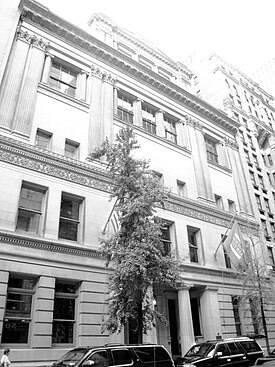House of the New York City Bar Association
|
Association of the Bar of the City of New York
|
|

44th Street facade (2010)
|
|
| Location | 42 West 44th Street, New York, New York |
|---|---|
| Coordinates | 40°45′20″N 73°58′56″W / 40.75556°N 73.98222°WCoordinates: 40°45′20″N 73°58′56″W / 40.75556°N 73.98222°W |
| Built | 1896 |
| Architect | Cyrus L. W. Eidlitz |
| Architectural style | Neoclassical |
| NRHP Reference # | 80026666 |
| Added to NRHP | January 3, 1980 |
The House of the New York City Bar Association, located at 42 West 44th Street in Manhattan, New York, is a New York City Landmark building that has housed the New York City Bar Association since its construction in 1896.
After the New York City Bar Association was founded in 1870, it housed itself in a series of buildings in lower Manhattan. By the 1890s, membership of the Association had grown to the point where its leadership began looking for a new House farther uptown. On December 11, 1894 the membership approved the acquisition of a large site between West 43rd and West 44th Streets for the construction of a new, larger building. The street, already home to the Harvard Club of New York and the Century Association, was considered by the members “specially adapted to our purposes” because of the other prominent clubs and societies in its vicinity.
The prominent architect Cyrus L.W. Eidlitz, son of the influential New York architect Leopold Eidlitz, was commissioned to design the building. Eidlitz had designed a number of landmark buildings throughout the country, including Dearborn Station in Chicago, Buffalo & Erie County Public Library, St. Peter’s Church in the Bronx, and Bell Laboratories Building in Manhattan.
Construction was begun in early 1895 and completed 18 months later at a total cost of $584,700. The House was built in the neoclassical style, from Indiana limestone. The façade included elements of the Doric order on the bottom three floors, Ionic columns framing the fourth floor windows, and Corinthian pilasters on the fifth floor, creating a historicist “composite” of classical architecture.
...
Wikipedia

